By Meera Satpathy, Founder and Chairperson, Sukarya
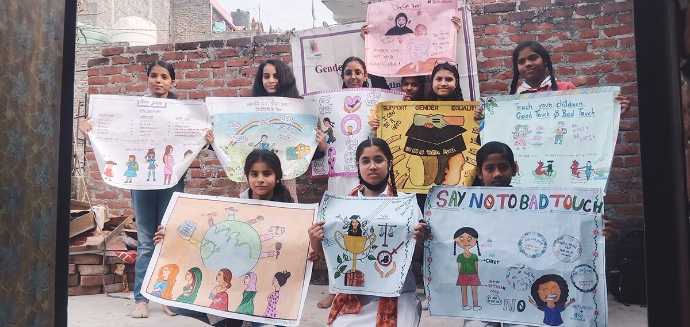
Adolescent Girls Advocate for Gender Equality and Safety through Powerful Posters. Photo: Sukarya
Understanding Gender Equality: A Foundation for Change
Gender equality ensures that women, men, girls, and boys have equal rights and access to resources, opportunities, and protections. Investing in gender equality has lasting positive impacts on children and their communities, creating significant benefits across generations. When women’s rights and well-being are upheld, children’s rights and overall well-being also improve.
Global Gender Disparities: Where Do We Stand?
Gender Equality in Childhood: The Early Years Matter
In early childhood (0-9 years), gender gaps are minimal. Birth registration and immunization rates are similar for boys and girls. In many countries, girls aged 3-4 show better developmental progress than boys. Both genders face identical risks of violent discipline at home.
The Adolescent Gender Gap: Challenges and Consequences
Gender disparities intensify in adolescence (10-19 years), shaping attitudes and reinforcing gender norms. Puberty often limits girls’ mobility, education, and social exposure, increasing their domestic workload and risks of early marriage, pregnancy, and violence.
Key statistics:
- Girls aged 10-14 spend twice as much time (21+ hours weekly) on household chores as boys
- 22% of girls aged 15-19 are not in education, employment, or training (NEET) vs. 13% of boys
- In 2023, girls accounted for 70% of new HIV infections among adolescents (15-19).
- 48% of adolescent girls (15-19) lack access to modern family planning.
- 13 million girls (15-19) have experienced forced sex.
- 4 million girls undergo female genital mutilation (FGM) annually.
- Maternal health issues are the second leading cause of death for girls aged 15-19.
- Self-harm ranks as the third leading cause of death among adolescent girls (15-19).
How does the U.S. rank for gender equality?
As of 2024, gender equality in the U.S. shows progress alongside ongoing challenges.
Key Statistics:
- The percentage of women in opposite-sex marriages earning as much as or more than their husbands has tripled over 50 years.
- The U.S. ranks 44th on the Gender Inequality Index (GII).
- Maternal mortality stands at 19 deaths per 100,000 live births.
- Adolescent birth rate: 16 per 1,000 girls.
- Women hold only 27% of congressional seats.
- Workforce participation: 55.2% of women vs. 66.4% of men.
- 5% of women have received secondary education.
Social & Legal Landscape:
- Shifting Attitudes: Young women are more likely to advocate for gender equality than men.
- Legislation: The 2024 “Protecting Women’s Private Spaces Act” aims to restrict transgender bathroom access.
- Equality Act: Proposed multiple times to ban sex, sexual orientation, and gender identity discrimination but remains unenacted.
India’s Gender Equality Progress: Key Developments and Challenges
Over the past two decades, India has seen improvements in women’s and girls’ lives, including declines in fertility rates, higher educational attainment, and better economic opportunities. However, challenges persist across various sectors like political representation, education and workforce, safety and violence, and legal and policy issues:
- Women’s Reservation Bill: In 2023, a law was passed to reserve 33% of seats in the Lok Sabha and state assemblies for women, effective after the 2026 delimitation.
- Parliamentary Representation: As of February 2024, women hold 14.7% of seats in India’s parliament.
- Education: Female enrolment in higher education has increased, though cultural norms and safety concerns hinder full participation in the workforce.
- Workforce Participation: Female labour force participation remains low at just under 33%, far below the global average of 47%.
India’s Global Gender Rankings in 2024
Gender Inequality Index (GII) measures gender inequality in reproductive health, empowerment, and labour market participation. A lower score indicates greater equality.
- Global Gender Gap Index: India ranked 129th out of 156 in the World Economic Forum’s 2024 report, down from 127th in 2023. The country has closed 64.1% of its gender gap, with significant disparities in education and political representation.
- SDG Gender Index: Ranked 91st out of 139 with a score of 61.2. The 2024 report highlighted India’s fast progress from 2015-2022 and projected continued improvement toward 2030.
Global Leaders in Gender Equality (2024)
The global gender gap was 68.5% closed in 2024, but no country has achieved full equality. According to the World Economic Forum’s Global Gender Gap Report, Iceland remains the most gender-equal country for the 15th consecutive year.
Top 10 Countries for Gender Equality in 2024:
- Iceland (Ranked #1 for the 15th year in a row)
- Norway
- Finland
- New Zealand
- Sweden
- Germany
- Nicaragua
- Namibia
- Lithuania
- Ireland
Gender Equality in India: Progress and Challenges
Empowering girls is key to India’s progress. By valuing girls, we can achieve short-term goals like improving education access and reducing anaemia, medium-term goals such as ending child marriage, and long-term targets like eliminating gender-biased sex selection.
Creating lasting change requires involving men, women, and boys across all sectors only when society’s perception shifts will the rights of both girls and boys be fully realized.
Providing girls with education, safety, skills, and social support can reduce risks and unlock their potential, enabling them to contribute meaningfully to India’s growth. However, girls often struggle to access life-saving resources, information, and networks.
Tailored programs focusing on education, life skills, and protection from violence—especially for vulnerable groups, including those with disabilities—can build resilience and create lifelong opportunities. Long-term solutions designed with and for girls will pave the way for a more equitable and empowered future.
Adolescent Girls Advocate for Gender Equality and Safety through Powerful Posters. Photo: Sukarya
Sukarya’s Gender Equality Program for Adolescent Girls and Boys (2023-2025)
This initiative aims to empower adolescent girls and boys through structured training sessions, fostering gender equality awareness and breaking societal barriers. This program is crucial in promoting gender equality by addressing systemic challenges and encouraging positive change in adolescent boys and girls.
Funding Partners
- ERAN – Fund for Women (Gurugram)
- Hughes Systique (Delhi)
- USA-Sukarya
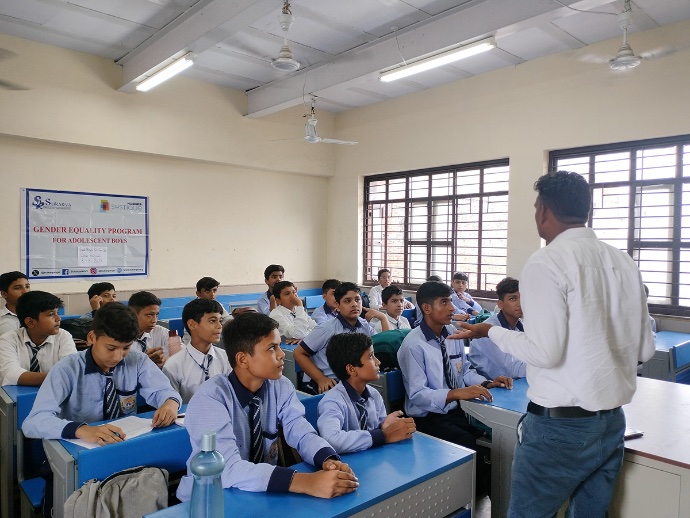
Training Session for Adolescent Boys at a Government School in Delhi. Photo: Sukarya
Key Challenges Faced
- Ensuring Regular Participation – Girls face obstacles in attending all six training sessions.
- Social Stigma & Resistance – Objections from school authorities, teachers, and parents hinder engagement.
- Migration & Displacement – Families frequently relocate due to livelihood needs or unauthorized area demolitions, making follow-ups difficult.
- School Schedules – Adjusting training plans to fit within school curricula and routines.
- Parental Involvement – Low participation in orientation sessions due to parents’ work commitments.
Key Accomplishments:
- Expanded Reach – Successfully conducted training sessions across schools and communities.
- Parental & Teacher Engagement – Orientation sessions held to ensure active support for gender equality at home and in schools.
- Quantitative & Qualitative Impact – Significant progress achieved in both outreach and impact metrics.
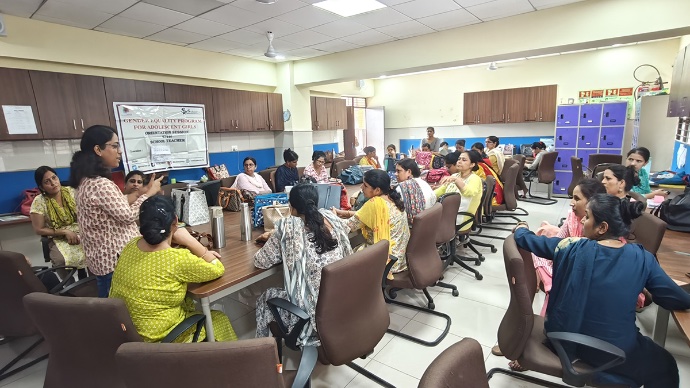
Teachers’ Training Session for the Gender Equality Program. Photo: Sukarya
Cumulative Impact (2023-2025):
- Total Girls Enrolled: 4200
- Total Boys Enrolled: 300
- Districts Covered: Gurugram & South Delhi
- States: Haryana & Delhi
- Total Schools: 23
- Total Communities: 21
Sukarya’s Initiatives for Women, Girls, and Boys in India
Sukarya is dedicated to enhancing the health, education, and economic well-being of women, girls, and boys in both urban and rural communities across India. The organization implements targeted programs focusing on critical issues such as maternal and child health, gender equality, nutrition, and economic empowerment.
Health & Nutrition Programs
Reproductive Maternal Child Health and Nutrition (RMCHN & A): It focuses on anaemia prevention, malnutrition treatment, and WASH (Water, sanitation, and hygiene) awareness.
Rural Community Health Action (RCHA): Delivers healthcare to rural areas, bridging gaps with comprehensive health initiatives for all.
Urban Slum Health Action Program (USHA): Delivers accessible healthcare services to urban slums, focusing on preventive care and sustainable wellness.
Key Initiatives:
- Running health clinics offering diagnosis, treatment, antenatal & postnatal care, medicine distribution, lab tests, counselling, and referrals.
- Ensuring timely immunization through collaboration with government health departments.
- Conducting nutrition awareness sessions, cooking demonstrations, and providing nutritional supplements.
- Organizing sanitation campaigns to promote hygiene and boost child immunization rates.
- Home visits and follow-ups by ASHA workers, community health workers, and door-to-door awareness campaigns.
Key Activities:
- Nutrition awareness sessions and cooking demonstrations to promote affordable, nutritious diets.
- Immunization drives in collaboration with government health departments.
- Sanitation campaigns promoting hygiene and WASH practices.
- Regular home visits by community health workers for awareness and follow-up.
Sukarya Swasthya Kendras: Healthcare Within Reach
Providing essential healthcare services to underprivileged communities, particularly in Gurugram’s Saraswati Kunj and nearby slums.
Services Offered:
- Weekly physician consultations, medical check-ups, and medicine distribution.
- Diagnosis and treatment by female MBBS doctors, antenatal & postnatal check-ups, and lab tests.
- Preventive services include health awareness sessions, community meetings, and home visits.
- Monthly Mother and Child Health Days in collaboration with government health and ICDS departments.
Gender Equality Initiatives
Empowering adolescent girls (10-19 years) through healthcare, education, and skill-building in reproductive health, menstrual hygiene, family life, gender rights, and digital literacy.
Implementation Areas:
- Government Schools and Communities: Providing structured education on gender rights and health.
Program Objectives:
- Educate adolescent girls on reproductive and sexual health.
- Provide digital literacy and skill development to enhance employability.
- Raise awareness about WASH practices for better health and hygiene.
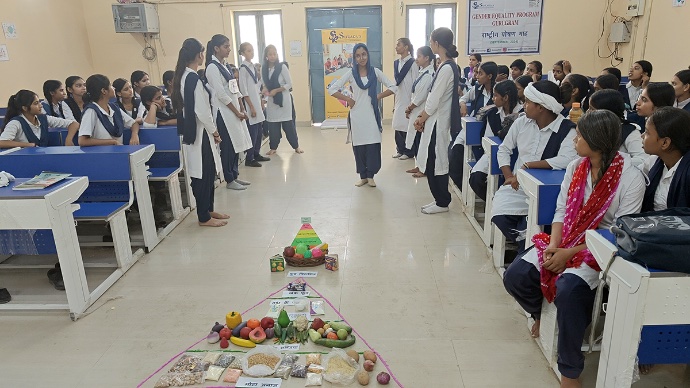
Adolescent Girls Perform a Play on the Importance of Nutrition, Raising Awareness Through Interactive Learning. Photo: Sukarya
Social Behaviour Change Communication (SBCC) Project
A specialized adolescent health initiative promoting gender-sensitive behaviours and awareness.
Women’s Economic Empowerment
Empowerment of Rural Women through SHGs & Entrepreneurship: Promotes economic self-reliance through Self-Help Groups (SHGs) and livelihood initiatives.
Key Focus Areas:
- Skilling and resource pooling to boost income generation.
- Guidance on entrepreneurship and market linkages.
- Building confidence and fostering collective strength among women.
Nutrition & Education for Children
Nutrition Intervention for Education on Wheels (EOW) Children: Provides children with essential nutrition and education, laying a foundation for healthier and brighter futures.
Sukarya’s multi-faceted approach ensures a lasting impact on the lives of women, girls, and boys, enabling them to lead healthier, more empowered lives.
Sukarya Partners with the Obama Foundation’s Girls Opportunity Alliance
Sukarya was proud to be a featured Girls Opportunity Alliance organization, strengthening our commitment to adolescent girls’ empowerment. Through this 12-month initiative, we provided knowledge, life skills, leadership training, and resources to help girls complete their education and build a confident future.
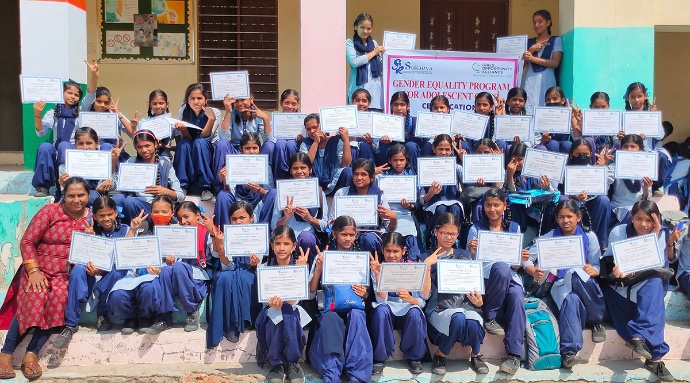
Certification Ceremony for a Batch of Girls Trained Under the Gender Equality Program. Photo: Sukarya
This partnership, guided by Michelle Obama’s inspiring leadership, is a decisive step toward gender equality. We were excited to share updates and gain insights from this collaboration!
Sources:
https://data.unicef.org/topic/gender/overview/
https://www.unicef.org/india/what-we-do/gender-equality
https://india.un.org/en/172095-gender-equality-and-youth-development
https://sukarya.org/2021/07/04/a-valued-partnership-in-the-time-of-covid-19/